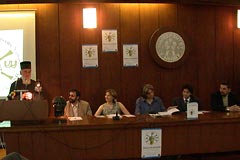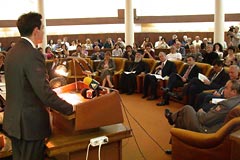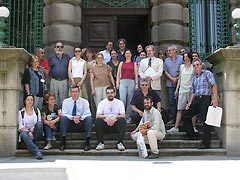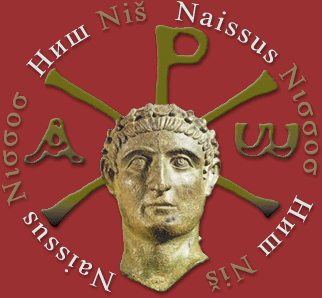

"BYZANTIUM ROOTS OF MODERN EUROPE"
II International Symposium
Niš, 03-05 June 2003
 Within the celebration of the Day of St. Emperor Constantine and empress Helen, the City of Nis organizaed the second international scientific symposium on the theme "Byzantium Roots of Modern Europe", from 3 to 5 June 2003. The symposium was held at the Nis University Hall. In cooperation with the Archeological institute and thanks to the kindness of the French Cultural Center from Belgrade, in the looby in front of the University Hall there was set up the exibition "The City of Empress" 3D restitution of the Acropolis introduced to the guests by dr Vujadin Ivanisevic and opened by Mr. Vladimir Domazet, the Nis Municipality president.
Within the celebration of the Day of St. Emperor Constantine and empress Helen, the City of Nis organizaed the second international scientific symposium on the theme "Byzantium Roots of Modern Europe", from 3 to 5 June 2003. The symposium was held at the Nis University Hall. In cooperation with the Archeological institute and thanks to the kindness of the French Cultural Center from Belgrade, in the looby in front of the University Hall there was set up the exibition "The City of Empress" 3D restitution of the Acropolis introduced to the guests by dr Vujadin Ivanisevic and opened by Mr. Vladimir Domazet, the Nis Municipality president.
The beginning of the scientific symposium work was blessed by Mr. Irinej, the Bishop of Nis, the participants were welcomed by the Mayor Mr. Goran Ciric, and the symposium was opened by the Minister for culture of the Republic of Serbia, Mr. Branislav Lecic. The participants and guests were addressed by prof. Adriana Poli Bortone, the Mayor of the City of Lece and a member of EP, on behalf of the European Parliament with the words of support.
 Prof. dr Aleksandar Kadijevic introduced the Proceedings "Nis and Byzantium No.1" from the last year symposium.
The eminent researchers gathered this year around the theme "Byzantium roots of modern Europe", with the aim to moderate the cultural delusions and indicate the contribution of the Byzantine world in formation of modern European civilization. The anciant cradle of culture, the Balkans with Nis as an avoidable center, is a firm reliance to the forthcoming integration processes of modern Europe. Cultural getting closer leads to the national uniting, to the long ago forgotten Byzantine dream about the Empire unity.
Prof. dr Aleksandar Kadijevic introduced the Proceedings "Nis and Byzantium No.1" from the last year symposium.
The eminent researchers gathered this year around the theme "Byzantium roots of modern Europe", with the aim to moderate the cultural delusions and indicate the contribution of the Byzantine world in formation of modern European civilization. The anciant cradle of culture, the Balkans with Nis as an avoidable center, is a firm reliance to the forthcoming integration processes of modern Europe. Cultural getting closer leads to the national uniting, to the long ago forgotten Byzantine dream about the Empire unity.
Misunderstandings, miscomprehensions or some old delusions about Byzantium of past times are slowly left behind due to the scientific arguments exposed also at the Nis symposium.
35 participants presented their paper works, 1 from England, 4 from Bulgaria, 3 from Macedonia, 1 from Greece and the rest from our country.
Radivoje Radic, Belgrade - "Contribution of the Byzantine doctors to the medieval medicine" - indicates the contribution of the Byzantine medicine to the improvment of the diagnostic skills and the therapy, surgery operation techniques, pharmacology and pharmacy.
Nebojsa Ozimic, Nis, - "The role of the Templars in spreading of the Byzantine cultural influence in West Europe" - The Templars sojourn on the Byzantium theritory is important for the development of the medieval West. The knowledge from Byzantium reaches to Europe what is reflected in the architecture, literature and fine arts.
Sava Lausevic, Niksic - "Isihastic energizm" - deals with the relation between the isihasma movement and modern philosophic ideas. It strengtens the hypothesis that the Byzantium isihasm has its postbyzantine forms in the modern philosophy, esspecially in ethics.
Boris B. Brajovic, Niksic - "Cosmopolitism - Byzantine themes" - diverts attention to two parallel courses in the core of the united Europe - a cosmopolitan, whose its basis finds in the theological thought of the Byzantine East and a mondialistic, which develops under the wing of the Latin West.
Karmen Angela Cvetkovic, Nis - "Fourth century holy fathers on priesthood" - presented the activities of the holy fathers from IV century in the struggle for the ortodox church in the overtaken social circumstances.
Vladimir Cvetkovic, Nis - "God and the world in the works of st. Irenaeus of Iyon" - considers the creativity of st. Irenaeus from Lyon related to the relation between the God and the world.
Dragisa Bojovic, Kosovska Mitrovica - "Slavic St. Jefrem in the European science" - gave the analysis of the slavic scripts of st. Jefrem from Siria (306-373) as well as the review of the research in the context of the relation the cyrillic scripts and so called "rilski" scripts.
Graham Jones, Leicester - "The Cults of St. Constantine and St. Helen from western perspective" - The cult of St. Constantine and St. Helen has been comprehended from the perspective of the West and there was shown its prevailing in the region of England.
Aleksandra Nitic, Belgrade - "Cloth and profane costum in the Serbian painting of XIV and XV century - the origin and development of style" - On the samples of cloths from the portraits and from the preserved fabrics there were found different style elements of the Serbian medieval costume and among them there were noticed some details originating from the West.
Mihajlo Milinkovic, Belgrade - "Archeology of fashion as the archeology of of the identity" - The manner of dressing of Romej and the barbarians (V-VI century) was shown on the basis of several samples and finds, of which one originates from Nis, considering the information from the written sources.
Dragica Premovic-Aleksic, Novi Pazar - "Late antique and early Byzantine fortifications in the Novi Pazar surrounding" - She exposed the results of the systemathically recognition of the Novi Pazar region. It is obvious density of population and the presence of the military troops during VI century, when a greater number of fortifications was restored and built.
Dragisa Milosavljevic - "The phenomenon of the Byzantine hospital in St.Georgie in Dabar" - The discovery of the late Byzantine hospital in the monastery St.Georgie in Dabar (Mazici near Priboj) in 2001 and 2002, with the greater part of equipment, apparata and surggery instruments appropriate to the much more developed European regions, implies the numerous cultural and civilization questions and changes our opinion about the Byzantine medicine.
Radomir Petrovic, Belgrade - "Frescoes from the miracle and legends of the emperor Constantine the Great in the monastery in Pribojska Banja from 1574 " - He delt with the primar frescoe layer of the monastery Banja from which is learnt the spiritual climate of the Turkish slavery times and the tendency of establishing the genealogical relations and the cult of the emperor Constantine and Nemanjici.
Viktor Lalcic, Skoplje - "The early Byzantine towns in the Skoplje-Kumanovo region" - In this application the latest results of the early Byzantine towns researching were presented: Davina Kula, Orman village (Skoplje) and Velika Kulica, Karabicane village (Kumanovo).
Ioanis Sisiou, Kastoria - "Moving of painters from Kostur towards the north in the first half of XIV century" - He indicated an insufficiently known activity of the Kostur painting school during the first half of XIV century and negates the assumption about the half-century break of the painting activities. That is supported by the frescoes and icons that have lots of in common with the frescoes decoration of Donja Kamenica, Polosko, Treskavica and Lesnova.
Misa Rakocija, Nis - "The early Byzantine tomb on the arch near Klisura village by Nis and the short review of the problem of the arched tombs" - The new revealed tomb is the reason for the proposed typology and dating on the basis of the architectonic elements, applicable also to the other typically similar tombs.
Ivanka Gergova, Sofia - "Nis metropolitans respected as the saints in Bulgaria in XIX century" - In XIX century the calendars with the saints were printed in Bulgaria and among them there were 3 Nis metropolitans; one of them was painted also in the church of the Panadjuriste town. The presentation gave the comments about whether these historical characters were real, how they got among the saints, what is the sense of that "canonization" for Bulgarians at the time of revival.
Gordana Milosevic, Belgrade - "Martirium and the tomb basilica in Jagodin Mala in Nis" - She collected and grouped all available documentation and made a try to establish the chronology of constructing of the martirium, basilica and the tombs and their interrelations.
Djordje S. Kostic, Belgrade - "Byzantine heritage in Bedekrim" - The origin of the modern guides for tourists is related to XIX century and to the issues of the publishing house of Karl Bedeker in Leipzig.
Draginja Maskareli, Beograd - " Hasenantique and typical projects for the church constructions in Serbia" - The architects of the Ministry for constrution Svetozar Ivackovic, Jovan Ilikic and Aleksandar Bugarski projected the typical chuch buildings in the spirit of hasenantique and througout Serbian villages, like in the Sicevo canyon St. Pasakeva in Ostrovica.
Sasa Mihajlov, Belgrade - "Neobyzantine elements in the architecture of Rajko Tatic" - The architect Rajko M. Tatic (1900-1979), originating from Nis, belongs to the group of the Serbian architects who were projecting between two World wars in all current styles balancing skillfully between different concepts.
Mirjana Masnic, Skoplje - "About the programe and style characteristics of the new revealed frescoes of the Porecki monastery in Macedonia" - The new revealed frescoes of the monastery church - Birth of the God's Mother - in the Porecki monastery are unknown to the science. By its idea program and by the monumentality they belong to the the most representative complex of the medieval Byzantine art.
Teodora Vasileva, Skoplje - "The scene "Melismos" in the church St.Virgin in Dolna Kamenica /XIV c./ " - She presented the example of the influence of the Serbian iconography tradition on the development of the frescoes painting in the Balkans.
Radmilo Petrovic, Belgrade - " Pons milvius et pons Naiss" - Relying to the document from the Nis Archive, in his work he connected the Nis bridge to Constantine's mother Helen as the fortune of the river about what the seal from the gold bullion from the end of IV c. testifies.
Zarko Zdrakov, Sofia - "Identification of the "Skeleton studio" according to the unpublished signatures from the monastery in Kremkovic and Poganovo" - Skeleton painting workshop was identified with five zographs signatures in the Kremikovac monastery (1493) and the two in Poganovo (1499). One signature localizes the studio in Fotanihsta village on the Skeleton lake.
Aleksandra Davidov Temerinski, Belgrade - "Traditional and new in the work of Dic Zograph -1819-1872/3" - His work reviewed through the icons for the Cathedral in Vranje represent the iconographic and style synthesis of the postbyzantine art with the style elements from the renaissance and mannerism to the rococo with the prevailing baroque influence.
Branka Ivanic, Belgrade - "Mara Brankovic and the monument od the of the the second half of XV c. painting " - She showed the scope of activities of Mira Brankovic according to the preserved charters and the attempt to connect certain painting monuments in the south-east Serbia with the known monuments of the south west Balkans region in the second half of XV c.
Tijana Boric, Belgrade - ""About the architecture of the church St. Archangel Mihailo and Gavrilo - a small Cathedral in Nis" - She indicated the achieved continuity of the postbyzantine architecture and divert attention to the icons from the iconostas that are classified into the most successful works of the early XIX c. in the southeast Serbia.
Jasminka Nikolic, Skoplje - "O tebe radujetsja" in the wall painting of the late medieval century in Macedonia" - This theme, mostly painted in the parvis of the monastery churches, appears in different variants, and in case of Slimnica and as so far the unique example of the consistent illustration of each poet verse with the particular composition.
Marica Maksimovic, Nis - "Finds from the location "the small Cthedral" in Nis " - She showed the results of the archeologic escavations in the porch of the small Cathedral.
Oliver Tomic, Belgrade - "Faum portraits and consular dipthisis" - He indicated the possible sources of the rulers scenes, churches' prelat and pontiffs in the medieval century. Faum portraits, Roman consular diptihs and the first icons formed the medieval portrait.
Georgi Gerov, Sofia - " St. Constantine et Helen - images a cote de l'entree de l'eglise" - He analysed and systematized the scenes of St. Constantine and Helen by the entrance of churches.
Dusica Zivanovic, Belgrade - "Beginnings of the Byzantine architecture studying in Serbia" - She indicated the significance of the work of Mihailo Valtrovic and Dragutin Milutinovic and of the foundation of the desk for History of the architecture with the Byzantine style.
Milca Ceranic, Belgrade - "The Church in rasnica (1885) - the example of of Ivakovic's architectonic neobyzantism " - She indicated the architectonic specialty of the resnik church and its significance for Ivakovic's and Serbian sacral architecture at the end of XIX c.
Aleksandar Kadijevic, Belgrade - "Evocations and paraphrasis of the Byzantine construstion in Serbian architecture between two world wars" - He exposed synoptically the development of that period architecture, and specialized the cupole of the Constantinopolis St.Sofia as the prevailing motive among Serbian architects. The Byzantine space solutions, elevations and decoration, are often joined with the elements of the Serbian medieval sacral architecture.
Due to justified reasons two of invited participants did not attend the symposium, but they will send their papers and these will be published in the Proceedings.
Archpriest Radomir V. Popovic, Belgrade - " Church circumstances at the time of the Emperor Justinian I (527-565) " - On the occasion of 1550. anniverssary of the 5th ecumenical meeting, 553-2003, this work paper is focused to the significance of the emperor Justinian I and his contribution to the theological discusions and debates in VI c. The emperor personaly wrote the theological works and participated actively as an ortodox believer and theologian in the maintenance of the ortodox religion.
Slobodan Mileusnic, Belgrade - "The mantle of the King Milutin - Liturgy use" - He offered a nice example of the liturgy development of use of the mantle and presented the mantle of the King Milutin from around 1300 with the addition from XVI c.
 The participants at the symposium had at disposal the video-bim and the projector as well as the modern equipment for the simultaneous translation. The special joy for the symposium particpants was the tour of the cultural monuments (Basilica with martirium, The Latin chuech in G. Matejevac, Mother of God church in the Sicevo canyon). This excursion turned into inspiring presentation by some participants about the visited monument and was ended by the inspiring discusion. The basic characteristic of the symposium is exceptionally working atmosphere, what has to stay the recognisible sign, of nowadays traditional Nis scientific symposium. Here should be pointed out the exceptional standing and enthusisam of the concomitant services of the City of Nis, the associates from the National Museum and the Institute for the cultural monument protection in Nis.
The participants at the symposium had at disposal the video-bim and the projector as well as the modern equipment for the simultaneous translation. The special joy for the symposium particpants was the tour of the cultural monuments (Basilica with martirium, The Latin chuech in G. Matejevac, Mother of God church in the Sicevo canyon). This excursion turned into inspiring presentation by some participants about the visited monument and was ended by the inspiring discusion. The basic characteristic of the symposium is exceptionally working atmosphere, what has to stay the recognisible sign, of nowadays traditional Nis scientific symposium. Here should be pointed out the exceptional standing and enthusisam of the concomitant services of the City of Nis, the associates from the National Museum and the Institute for the cultural monument protection in Nis.
The intention of the symposium organizers is that this gathering of the researches of the past grows into the traditional one here in Nis. In order to maintan the concept and the symposium tradition, as well as international connections and reputation which was confirmed by this year meeting, it would be necessary the appriopriate institution to overtake the professional responsibility for organisation and realisation of the scientific meeting, and with the support of the City of Nis. The established scientific and researching concept is the closest to the activity of the Institute for cultural monuments protection which disposes of the organisation and staff potential for upgrading the symposium to the higher level. To us remains the obligation to keep the tradition of Nis scientific symposium as the recognisible sign of our city, while the representative Work Proceedings after each gathering is the guarantee of its scientific elitism.
Miša Rakocija
Translated by Ana Mišić, coordinator

![]()


